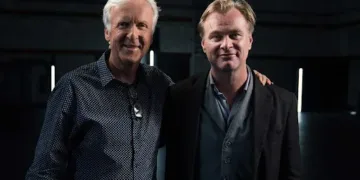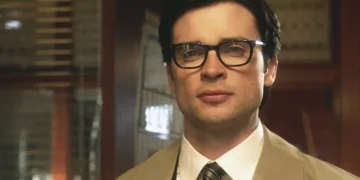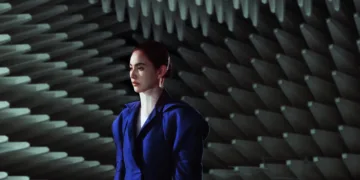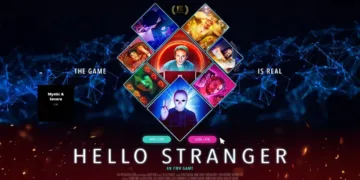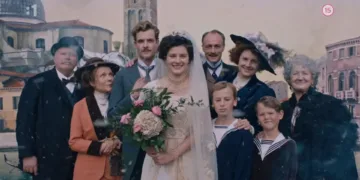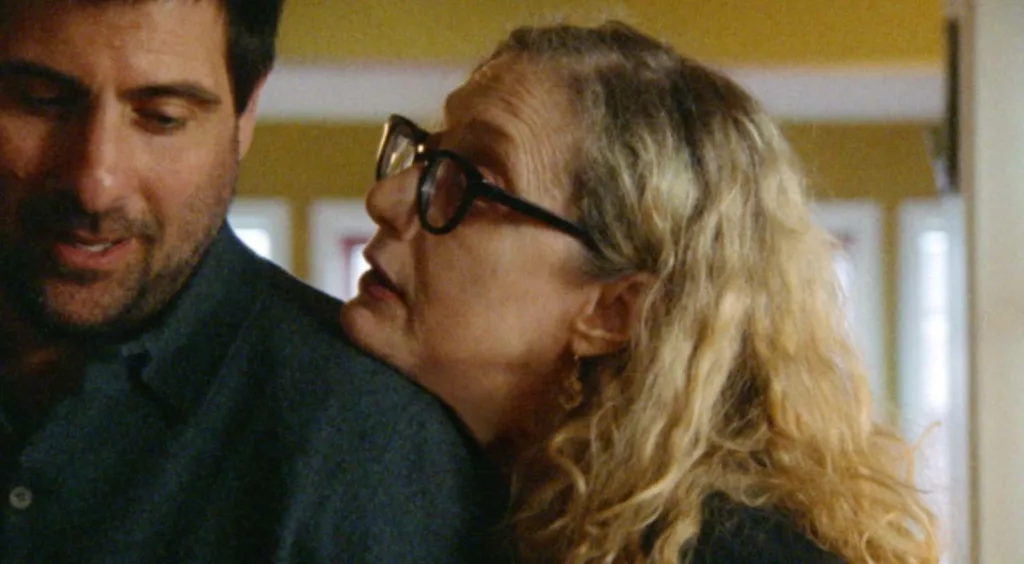Jason Schwartzman and Carol Kane shine as two oddballs brought together by chance in Between the Temples. This quirky dramedy from indie director Nathan Silver tells the story of Ben, a depressed cantor who loses his will to live after his wife’s death. Adrift in life, he crosses paths with his former music teacher Carla, an eccentric septuagenarian pursuing her long-held dream of having a bat mitzvah. What starts as a student-teacher role reversal blossoms into a tender friendship between two kindred spirits.
With its premiere at Sundance, Silver delivers his most high-profile and crowdpleasing film yet. While staying true to his lo-fi aesthetic, Between the Temples reveals glimmers of mainstream appeal. Schwartzman is perfectly cast as the schlubby, awkward Ben, offset by Kane’s energetic presence. Her legendary comedic chops are on full display, stealing scenes with impeccable timing.
Together, this unlikely pair share a gentle, affirming chemistry. Their bond defies societal norms, instead showing the transformative power of human connection. Poignant yet hilarious, Between the Temples promises to be a festival highlight.
Lost Faith and Lost Voice
Schwartzman departs from his usual charming roles to fully inhabit the depressed Ben. Once a cantor who found spiritual fulfillment in Jewish song, his inner light was extinguished by his wife’s shocking death. The grief proved too heavy for Ben, causing him to lose his voice and abandon his duties at the local temple.
Now a broken shell of his former self, Ben moves back home with his doting yet overbearing mothers. They dote on him to an suffocating degree, pushing Ben to “see doctors” in hopes of lifting his interminable sadness. Their meddling only strains their relationship further, with Ben retreating inward. He sees no possibility of happiness in the future, only the lingering pain of the past.
In his darkest moments, Ben actively wishes to join his wife in death. The film opens with him pleading for a truck to run him over, hoping to end his suffering once and for all. It’s only by luck he survives this suicide attempt, aimless and adrift. A chance run-in with Carla will prove his saving grace, but not before depicting Ben’s crisis of faith in visceral detail. Schwartzman’s committed performance lays bare his character’s desperate vulnerability.
An Eccentric Beacon of Light
In Ben’s darkest moment, he finds an unlikely lifeline – his former elementary school music teacher, Carla. Now in her early 70s, Carla proves the perfect foil to Ben’s morose demeanor. Kane embodies her with an energetic kookiness, speaking in hilarious vocal rhythms peppered with profanity. Far more vibrant than her age would suggest, Carla refuses to simply wind down in her sunset years. Instead, she decides to finally pursue a long-denied dream: completing a Bat Mitzvah.
Having been raised by communist parents, Carla was barred from the Jewish coming-of-age ritual as a teen. Though she married a stern atheist, Carla held onto her cultural curiosity over the decades. Once retired, she feels a pulling need to explore her religious roots more deeply before it’s too late. Ironically, it’s the cantor who has lost his own faith that inspires Carla’s spiritual journey.
In a delightful role reversal, Carla convinces a reluctant Ben to tutor her in Judaism’s rituals and beliefs. Despite no longer finding solace in religious song himself, he agrees to help Carla prepare the requisite Torah portion. Ben slowly rediscovers his love of music while guiding Carla’s studies, just as she breathes new life into his weary soul. Their student-teacher relationship takes on an almost mystical, incantatory quality – one lost sheep leading the other back into the flock.
Kindred Spirits
On the surface, Ben and Carla make an odd pair. Separated by over 30 years in age, societal norms would dictate they have little in common. Yet in their shared status as outsiders, never quite at home among their peers, a tender connection takes root. What begins as a practical arrangement – religious tutoring in exchange for voice lessons – blossoms into an unclassifiable bond transcending student and teacher roles.
United by their struggles with grief and faith, Ben and Carla provide a sympathetic ear to heal each other’s wounds. Through mushrooms and music, these two lost souls regain their zeal for life’s simple pleasures. Rather than romantic love, theirs is a more profound soulmate-like understanding. They recognize the inherent beautiful brokenness within one another.
The film explores themes of reconciliation – with one’s faith, relationships, and self-agency. Ben must renew his love of Judaism’s musical legacy, while Carla finally claims her religious identity on her own terms. They bolster each other’s self-belief first before finding it within themselves. This poignant message challenges societal efforts to label and constrain their connection by age or gender roles.
Like Harold and Maude before it, Between the Temples finds transcendent joy in one of life’s unlikeliest pairings. Kane’s warm, non-judgmental presence heals Ben’s wounded inner child, helping him embrace living fully in the moment again. Just as Maude taught Harold to take chances and nurture his creative spirit, Carla awakens Ben’s slumbering appetite for experience. Their innocent dynamic conveys a gently rebellious spirit, giving their middle fingers to societal norms.
Navigating Naysayers
Ben and Carla’s innocent friendship confounds those around them. Whether due to societal biases or concern for their loved ones, friends and family meet their growing connection with disapproval. Carla’s son assumes his mother will peacefully fade into retirement, and reacts with surprise to her newfound zeal for life. He questions if Ben is an appropriate companion on her spiritual quest.
Meanwhile, Ben’s mothers remain fixated on pushing their son to date women his own age – preferably nice Jewish girls. Comedy ensues from their tone-deaf meddling, like creating a JDate profile without his knowledge. Their rabbi even attempts to set Ben up with his own wayward daughter. Despite good intentions, these matchmaking efforts only drive Ben further from their understanding.
Through awkward encounters and stifled conversations, the film nudges viewers to confront our instinctive judgments about relationships with wide age gaps. Why do we view intimacy between younger women and older men more permissively than the reverse? What life experiences can possibly unite two souls born in different eras? Between the Temples argues for looking beyond superficial demographics to uncover the shared longings within.
In depicting this tension between romantic expectation and platonic affection, Silver walks a nuanced line. The precise nature of Ben and Carla’s attachment remains ambiguous, but undoubtedly profound. Their climactic declarations affirm choosing for oneself that which brings purpose and meaning. By fearlessly claiming their own path, this odd couple model the ultimate form of self-love.
Walking a Tonal Tightrope
In lesser hands, Between the Temple’s premise could easily spill into silly farce or cloying sentiment. Yet Silver walks a tonal tightrope with grace. Moments of awkward humor, even cringe comedy, perfectly balance the story’s essential sweetness. The film moves smoothly from laugh-out-loud hyjinks to blinking-back-tears poignancy.
Silver employs a claustrophobic filmmaking style to ratchet up the discomfort factor. Tight framings and handheld camerawork place us right amidst the social nightmare scenarios that haunt Ben. We palpably feel his angst. Yet these scenes only make the tender moments with Carla more affecting by contrast.
Schwartzman’s dragged-through-the-mud comedic persona finds an ideal partner in Kane’s signature kooky charm. Her occasional profanity-laced non-sequiturs lend the film a delirious quality. These reliable laugh generators allow Silver to explore grief and isolation with clear-eyed empathy.
In the end, Between the Temples remains hopeful about human resiliency despite acknowledging the realities of suffering. Its blend of awkwardness and compassion models a path towards social acceptance of unconventional yet harmless relationships. Judging by rapturous festival reactions, Silver may have perfected an approach with universal appeal.
Coming Together…Or Coming Apart?
The film builds towards two pivotal scenes that test the resilience of Ben and Carla’s special friendship. First comes an excruciatingly awkward Shabbat dinner that Silver stretches into a mini-endurance test for both characters and audience. This centerpiece sequence brings together the key players trying to pull Ben and Carla apart – his meddling mothers, the matchmaking rabbi and his daughter – with Carla the odd woman out.
We experience this ritual meal turned social nightmare from Ben and Carla’s perspective thanks to Silver’s intimate camerawork. We ache for the unspoken words and repressed feelings between them, on display for their clueless dinner companions. Just when it seems their bond will rupture under the strain, Ben and Carla reconnect with hopeful glances across the table.
Their climactic confrontation follows soon after, with Carla finally confessing her full intentions and the role Ben played in her spiritual awakening. Silver shows admirable restraint in his storytelling, allowing their revelatory declarations to land with subtle power. The precise nature of their attachment remains touchingly indefinite right through the enigmatic closing shot.
This ambiguous ending may frustrate viewers hungry for definitive resolutions. Yet it feels true to Silver’s understated style and his charismatic duo. Ben and Carla don’t merely defy societal rules; they playfully dance around verbally defining whatever exists between themselves. That appealingly loose, freewheeling quality permeates every frame.
The Joy of Defying Expectations
At its core, Between the Temples makes a case for embracing the unexpected connections that give our lives meaning. No bond holds more inherent value than any other; the divine can manifest equally through familial, friendly or romantic love. What matters is that it encourages mutual growth.
Kane delightfully demonstrates how advanced age need not limit one’s horizons. Her legendary talent remains undimmed, stealing scenes with infectious charisma. Schwartzman matches her enthusiasm for subverting his familiar screen persona. Together, their chemistry sells this offbeat couple as kindred spirits. Festival crowds responded rapturously, signaling a breakout moment for Silver.
The film leaves ambiguity around societal labels for relationships crossing generational lines. Yet it unambiguously champions the right to write one’s own unconventional story. Sometimes healing comes from those we least expect, from teachers becoming students, strangers becoming soulmates. With humor and heart, Between the Temples makes a thoughtful case for embracing the unexpected. Wherever it may lead us.
The Review
Between the Temples
With its funky wit and generous spirit, Between the Temples heralds the arrival of a potential new American auteur. Nathan Silver masters a tricky tonal balancing act, mining awkward laughs from painful scenarios while celebrating the restorative power of human connection. A breakout dramatic turn for Schwartzman and a welcome leading spotlight for Kane's singular talent. This poignant dramedy sings a sweet song of embracing life's beautiful messes.
PROS
- Schwartzman gives a career-best comedic performance
- Carol Kane steals the show with her quirky charm
CONS
- Ambiguous ending may frustrate some viewers
- Climactic revelations could use more narrative buildup
- Background on Ben's late wife feels incomplete
- Story drags slightly in middle sections














